COLLABORATORS: Raoul Middleman & Brian Garner
I had the distinct privilege early this month (Sept. 2013) to photograph two of Baltimore’s eminent art professionals at work: artist Raoul Middleman and master lithographer Brian Garner. Don’t take my word for it. Check out their websites: http://www.raoulmiddleman.com/ and www.lithoshop.net/
Raoul came to Brian’s Litho Shop to work on monotypes for two days. I arrived in the afternoon of the first day when they had already produced two sets of monotypes. Brian had pulled three impressions each of Raoul’s first two plates. For each Raoul created an image on a sheet of plexiglass with litho inks. The first impression from each plate was the brightest with the most contrast. The second impression was less brilliant; the third the most subtle.
I then photographed the creation of their third set. Both Raoul and Brian agreed to answer some question I would put to them via email. The following photo gallery is complimented by their responses.
Raoul, you seem to automatically know where to begin. I find it magical. Tell me what your initial intention was with this plate and why you started where you did.
I seem to start from a visceral excitement about the subject and then throw myself into the vast sea of possibilities, trusting to the fluidity of process to inform the image. In other words, whatever aesthetic meaning it has is in large measure a consequence of its being something that evolves and is full of surprises and discovery rather than a reiteration of some a priori idea. If you know what you are going to do before you do it, then the doing of it is superfluous. So one could almost start anywhere to keep oneself off balance, where balance is postponed to the precarious final resolution.
Brian, what was involved in setting Raoul up to work? What questions did you need to ask him? (What material was Raoul painting on?)
I knew Raoul wanted to make monotypes using oil-based lithography inks. He likes the consistency of them, and he knows how to modify them to suite his needs. Oil paints, something that he knows all to well could have been used, but he chose to use a medium that was different than he uses on a daily basis. He was painting the inks on plexiglass.
Raoul, what is it like to see yourself at work?
To see myself at work is always a bit of a shock. Like if a caterpillar saw a photo of its worm-like being while all the while its mindset was preoccupied with being a butterfly.
Raoul, I see see a second profile building here. Can you talk about these two profiles? Are you the darker one?
This image began vaguely with the idea of tango dancers, the male dark and the woman garishly colorful. Of course it wound up being something else. I wanted to put birds in the sky and then these morphed into first a kind of putti or cupid, then a cat with whiskers.
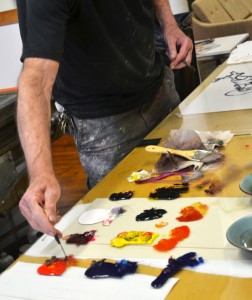
Raoul, is there method behind your arrangement of your palette?
The palette is simple; mostly the primary colors, red, yellow, and blue, reinforced with black and white.
Raoul, you’re approaching the finish line here and starting to smear the paint. You certainly don’t hesitate to surprise yourself. Is that a just way to describe your modus operandi?
I believe an image should transform itself from the the banality of its origin. Smearing, a combination of risk and metaphysical distain, could be a crude strategy for altering the pedestrian source of the image.
Brian, how much is this process a partnership?
It’s a complete partnership. Without Raoul’s talent and my input as a printmaker, there could be no prints. It’s very much like dancing, I’ll lead for a bit, then he’ll lead. Then we’re into the grove, and we know what each other is going to do next. I leave him alone when he is doing his thing, and he leaves me alone when it’s my turn.
Raoul, Do you consider Brian a collaborator in this project? How did he help you see what you were doing?
Brian is definitely an important collaborator in this project. The operation of the litho press can be likened to the sophisticated and canny use of a Stradivarius to bring out the beauty of the violin’s tone.
Brian, what were you looking for as you brought the plate to the press?
I was looking for “globs” of ink, overuse of solvent, and stuff like dust, brush hairs … anything that could impede a good impression.
Raoul, what were your thoughts before the first impression was pulled?
I hold my breath, like diving into water.
Brian, what are you doing here?
I was actually blowing on the plate to dry the solvents that were used to modify the inks. If it’s too runny, they will bleed on the paper.
Brian, on the first impression, you passed the roller over the plate three times, elevating the bed after the first and second pass? Why did you do this, and what did you learn with each pass?
The inks are built up on the plexiglass. When the rubber blanket passes over the plate, it slowly picks up the inks that are thicker, closer to the top. If the rubber was completely touching the plate, it would all squish out all over the place, just like rolling dough with a rolling pin. I don’t want to flatten the inks, I want to pick them up slowly on the blanket. This will allow me to get several impressions because all the ink will not be printed on the paper at one time.
Raoul, even though there’s no left-right reversal with using Brian’s press, how much is seeing the first impression a surprise for you?
It is always a surprise. More so in printmaking than anything else I do. The intermediary of the press seems to add a dimension to the experience. It is never just a replica of what I have put on the plate, rather an enhancement of its intentionality.
Raoul, what did your learn from your first two sets of prints of the day that you applied to the third?
I don’t think that I can ever apply what makes a work successful to the next challenge, only the knowledge that formulas don’t work; you have to start from scratch.
Brian, How is it to work with an artist as spontaneous of Raoul? How successful did you think your collaboration was?
Raoul knows his materials. He was born to work with his hands. His hands work without his brain telling him what to do. This does make for very spontaneous work and subject matter. It’s very exciting to work with someone when you have no idea what he is going to do subject wise and how he is going to lay down the materials. The collaboration was very good, but I am always hard on myself as a collaborator, wondering if I gave enough direction. Sometimes offering too much can distract an artist. I know when to talk and when not too. Every time we work with one another, the work gets stronger. Just like any relationship, with time, you know what that person needs, so you give it to them.
Raoul, can you tell me the strengths and weaknesses of these impressions? (The first impression is on the right; the second in the middle; the third on the left)
I would rather use my critical acumen on works other than my own. That said, I must confess to a struggle against my own temperament, the habit of putting too much in. However, Keats said that “poetry should surprise by a fine excess, rather than singularity.” But vulgarity being one of the components of my temperament, I don’t know about the use of the modifier “fine.”
Brian, Why did you pull three impressions of each plate? You seemed to gravitate to the middle impression of each series. Is that so? Why?
Working form the plexiglass plate on the offset press allows several impressions to be made from one “painting” on the surface. Technically, these are monotypes, not monoprints. Monoprints are prints that have a matrix that has an image that can be produced over and over again. Examples of that are etchings, engravings, lithographs, and relief prints. There is a permanent image that can be reproduced over and over again. If these images are then changed in anyway, for instance adding color by hand, or overlaying some other images on top of them in unique ways that differ from all the rest, you have a monoprint. Monotypes are taken from a flat surface, by subtracting ink or adding ink. Just like Raoul is doing. From that plate, I can get three to seven impressions, depending on how many he wants, and how long the ink last throughout the impressions. We ended up with three of each. He gravitated towards the middle impression. Not too dark, not too light. They are all the same, but have their own uniqueness within each one.
Raoul, You look like a kid in the candy store. How does the creative life make you smile?
I feel so fortunate in being able to do what I do. Being an intrinsic slob in any other profession would be be a major liability, but in art a proclivity to mess can be major asset to creativity.
Trackback URL: https://www.scottponemone.com/collaborators/trackback/

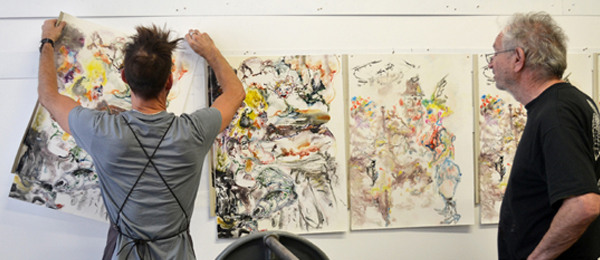
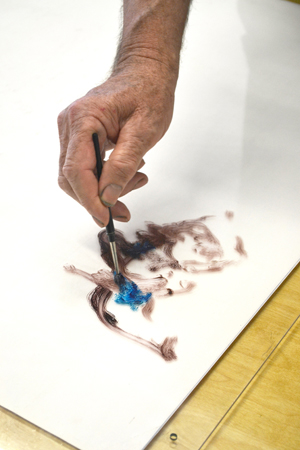
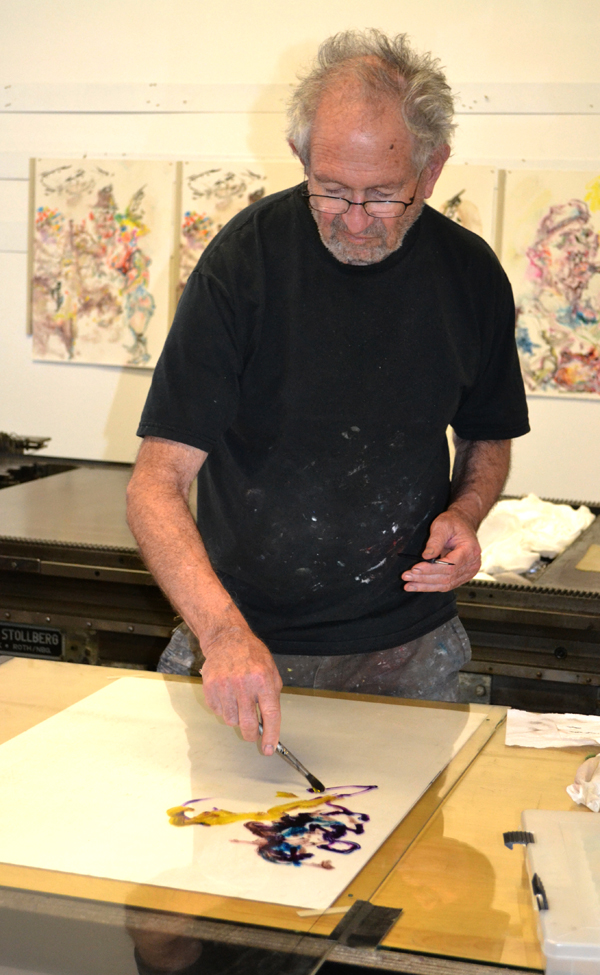
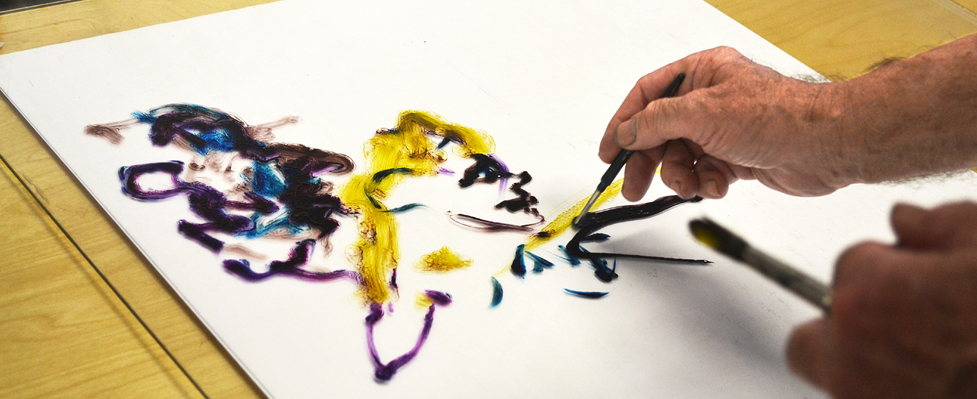
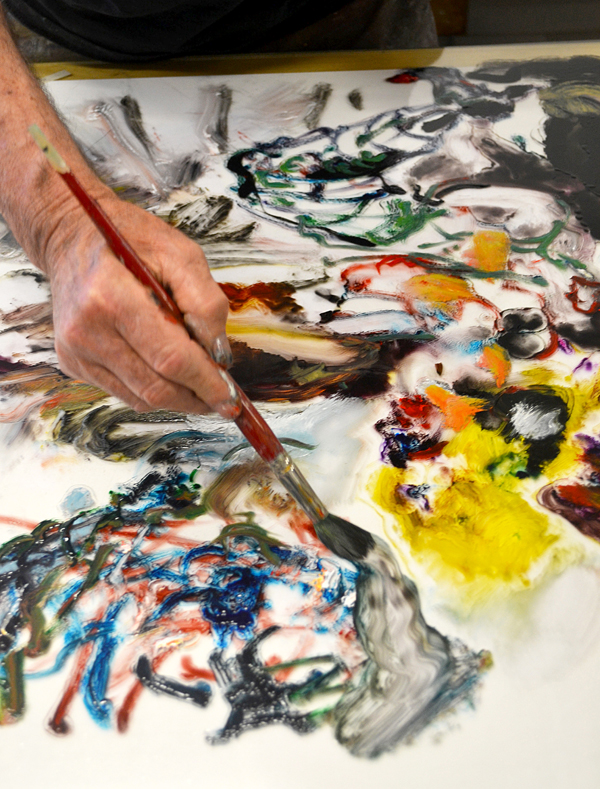
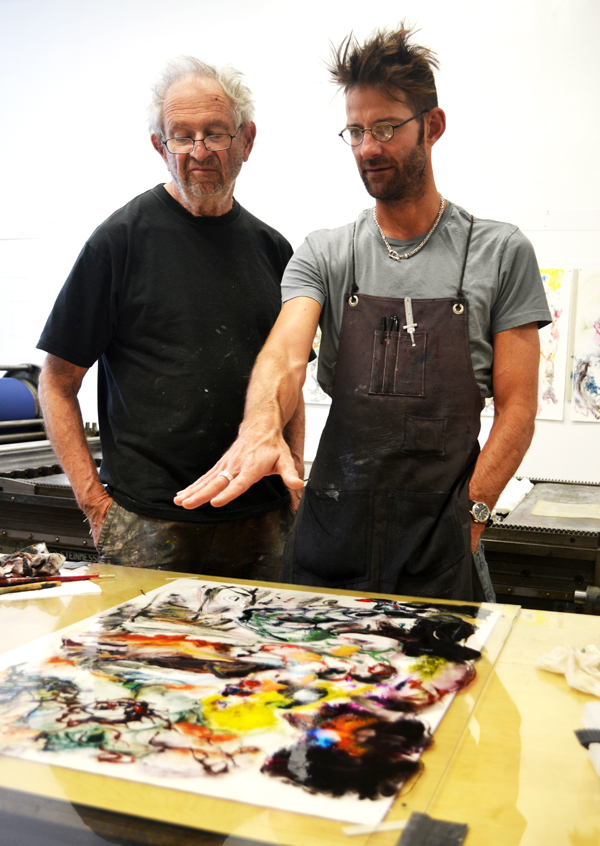

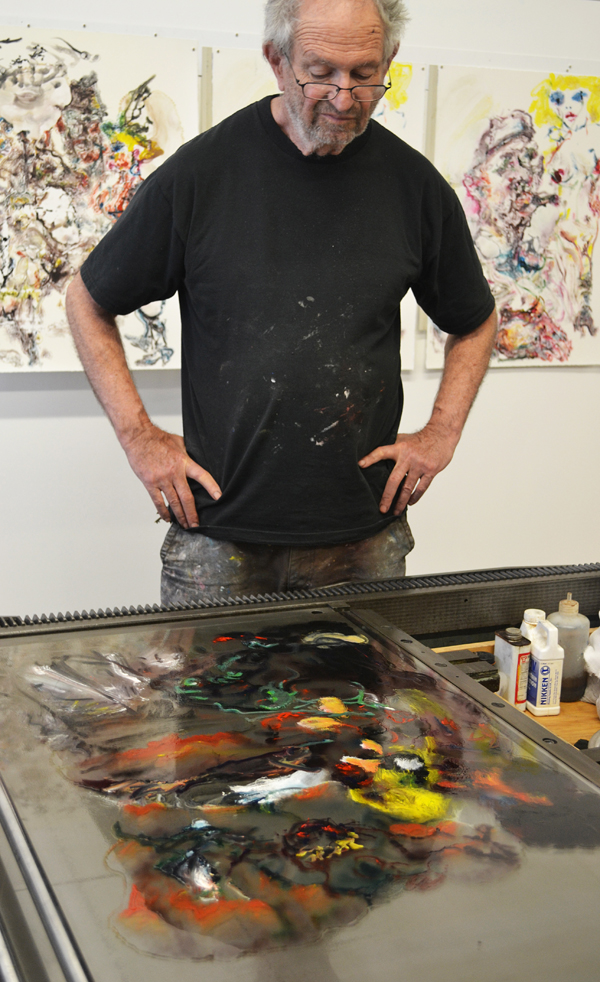
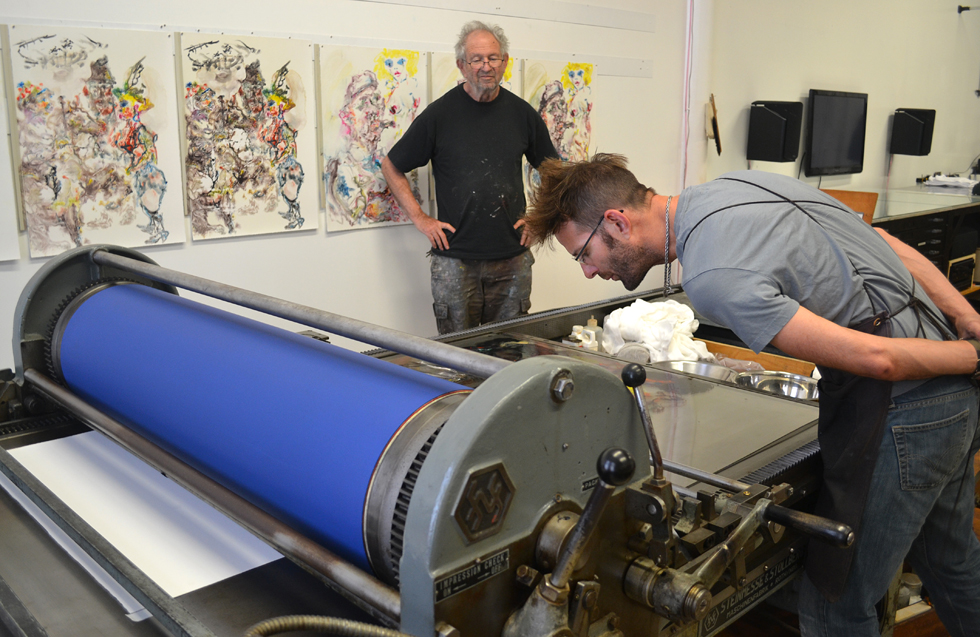
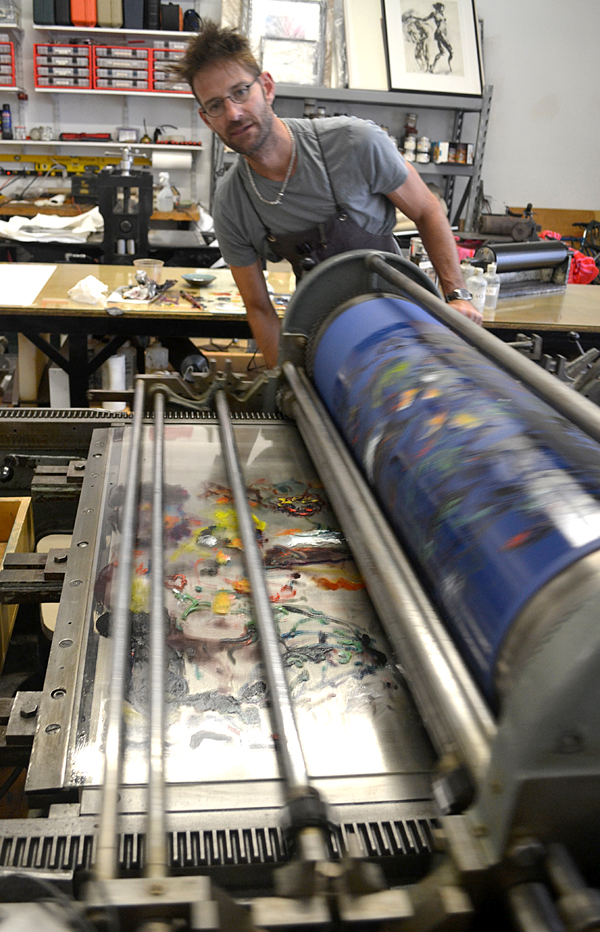
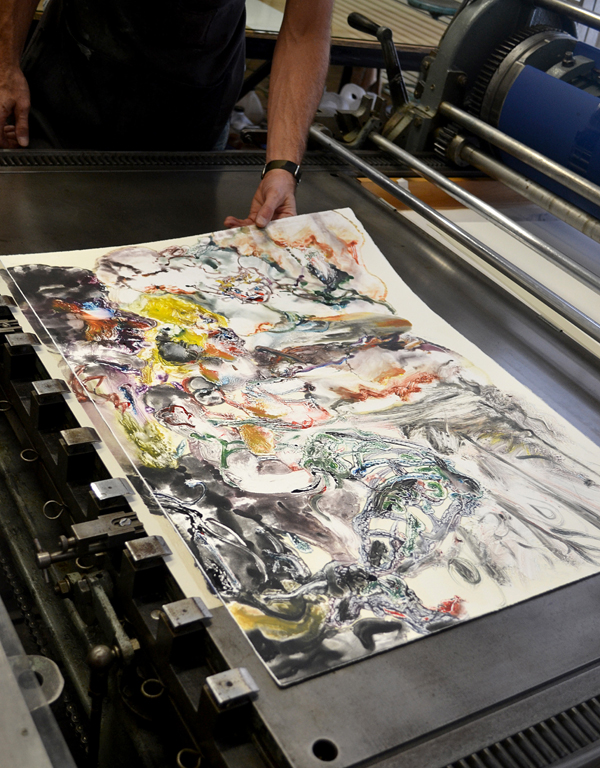
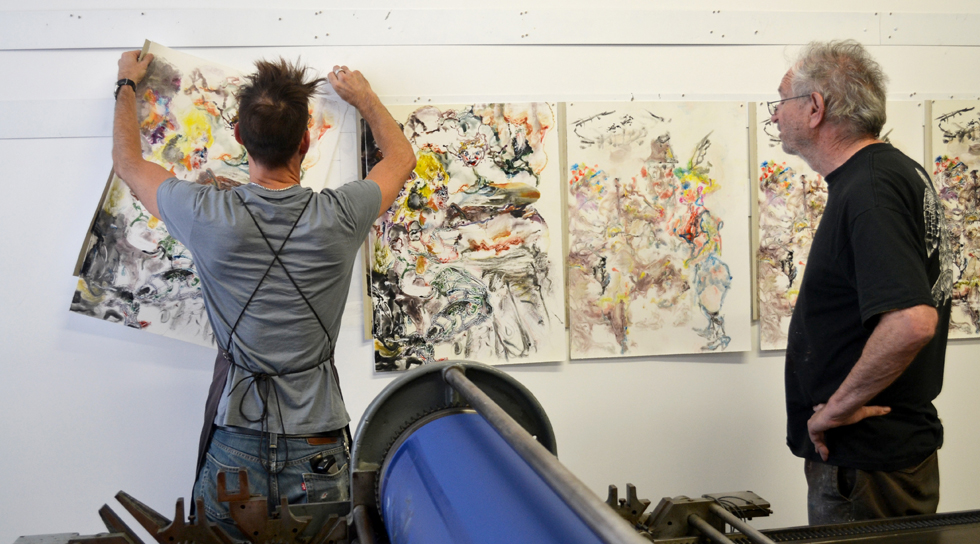
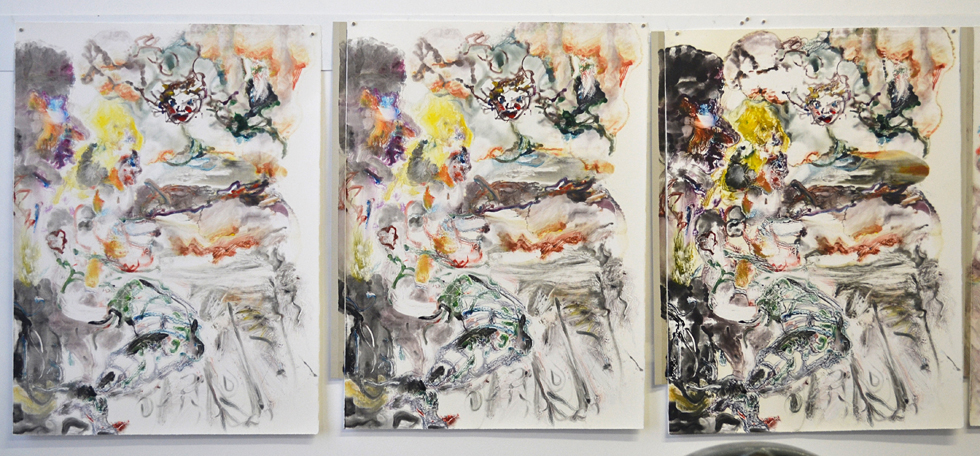
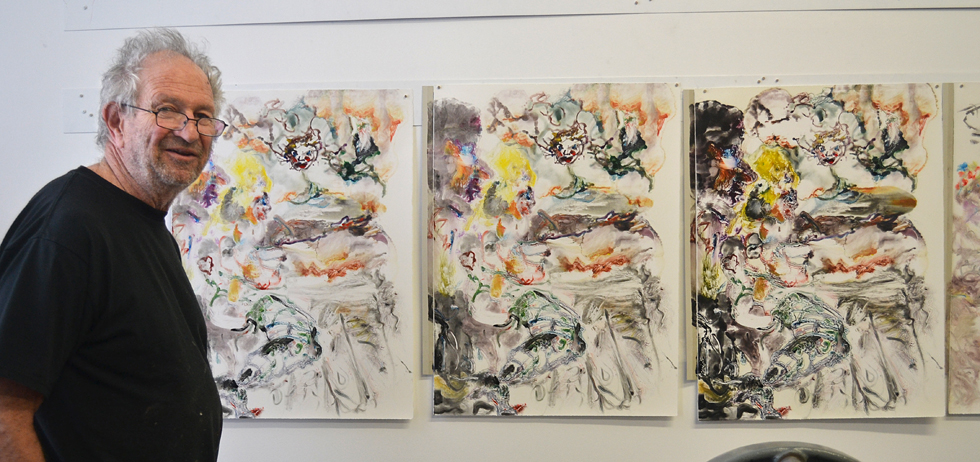










Fascinating. Great photos to go with narrative, too. And even though Brian explains the process, I am still amazed that the inks don’t “all squish out all over the place, just like rolling dough with a rolling pin.”
Thanks for your comments. As I said it was fun watching two pros at work/play.
Thanks for your comments. I felt as if I were present in the print shop. I learned more
about the print-making process. Give yourself credit for your idea and hard work.
Great interview! As an painter/printmaker the fascination with printmaking never bores me. Brians operates his press & shop with absolute certainty.I have also worked @ Lithoshop and it was an inspiring experience. I hope to be back soon to create something exquisite, of course with his help!
-Rachel Henriques, artist.